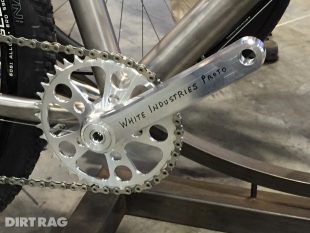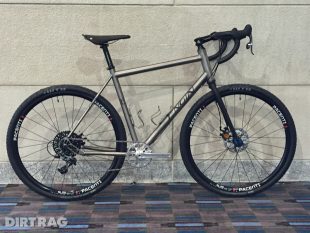T47: More standards, more problems, or one bottom bracket shell to rule them all?
Originally posted on November 9, 2015 at 10:57 amYears ago, in search of more stiffness, cranks with 30 mm aluminum spindles were introduced. Unlike the steel 24 mm spindles already on the market, those new oversized spindles didn’t work with the established threaded BSA bottom bracket. This led to a new standard: BB30.
The BB30 standard involved bearings installed directly into frames and snap rings to hold them into place. The oversized shell also made it easier to connect modern oversized tubing. In theory this system should work fine but, in practice, the tolerances needed to make it all work proved problematic for most everyone that made frames to this standard. This led to noise, bearing play, short bearing life and unhappy riders.
Next up? PF30, a press fit version of the same standard. Much like a headset, the bottom bracket bearings were installed in a plastic or aluminum cup which were pressed into a threadless bottom bracket shell. This certainly made it easier to assemble a bike and—again, in theory—the cup should remain quiet and be able to make up for small deviations in tolerances. The PF30 bottom bracket shell is also almost universal, with inserts available to run 24 mm spindles, standard threaded bottom brackets, and even eccentrics to tension a chain for singlespeed or IGH use.
But, once again, theory was no match for real world use and abuse, and riders are left to deal with noise and short bearing life. The aftermarket has been hard at work to help with this, creating bottom brackets that thread to themselves, helping to keep things quiet. Wheels Manufacturing, Enduro and Praxis Works all make well-regarded thread together bottom brackets that seem to be keeping a lot of people happy.

Never ones to stop improving on things, some frame builders and smaller component manufactures started to close in a solution. In the end, much like the 44 mm headtube that allows for straight or tapered steerers, the T47 standard is a “duh, why didn’t I think of that” moment: take a standard PF30 bottom bracket shell and thread it with 47 x 1 mm threads and make a matching bottom bracket.
In theory (there’s that word, again) a T47 bottom bracket should offer the creak-free performance of the English threaded bottom bracket while enabling the use of any crank standard on the market, and easily adaptable to both future standards and the current crop of fat bike bottom bracket widths.
There has been much moaning about another standard, and considering what is happening with axle spacing these days (which isn’t settled yet), it isn’t surprising and not entirely unwarranted.
But unlike most new standards, T47 is very backward compatible. While the 47 mm diameter isn’t a widely available size, it allows all metal PF30 shells to be threaded with the taps that will be available in a month or so. Those taps will fit the common Park Tool tap handles that most shops already own. The 47 mm diameter means that all frame building fixtures for PF30 won’t need to change. Most eccentric inserts for PF30 will still work fine in a T47 threaded shell. The 1 mm thread pitch is similar is what is used in English shells, and is fine enough to ease cutting in notoriously difficult titanium shells.
In my opinion, these are solid reasons to go with 47 mm versus using a readily available size like 48 x 1.5 mm. With a solid core of builders and component manufactures behind this open standard, I expect it to become widely accepted—and relatively quickly.
These are the minds behind the new standard (in alphabetical order):
Chris King Precision Components
I had a hard time getting hold of Engin, Paragon and White Industries to chat about this, as all three were traveling for the Philly Bike Expo but, in a moment of bike industry magic, I managed to get through to Alec White on his cellphone while he was in a car with Drew Guldalian from Engin and Mark Norstad from Paragon.
Here’s Ben from Argonaut Cycles breaking it down:
Below are some photos of the White Industries bottom bracket, Paragon bottom bracket shell, and Engin complete bike with T47 bottom bracket.


What’s your take, dear reader?

